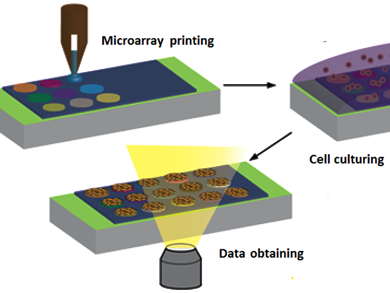Heart valve malformations affect about 1 % of population, requiring costly and high risk open heart valve replacement surgeries using mechanical or biological heart valve prostheses. Both kinds are error and failure prone, leading to more surgeries on the same patient and increasing the cost of healthcare. Understanding the developmental mechanisms of native nascent valve leaflets from a certain subset of endocardial cells via an endothelial-to-mesenchymal transformation (EndMT) is instrumental in regenerating heart valves from progenitor cells in laboratory conditions.
Ali Khademhosseini, Harvard Medical School, Cambridge, MA, USA, Keekyoung Kim, University of British Columbia, Kelowna, Canada, and colleagues developed a tissue regeneration technique based on a microarray – a technology where proteins, cells, and growth factors can be layered on top of hydrogel-coated glass slides to study the interactions between these critical components in tissue growth and regeneration on a microscale level. The study involved 60 different combinations of extracellular matrix proteins (Fibronectin, Collagen I, II, IV, Laminin) and growth factors (TGF-β1, bFGF, VEGF) and was able to pinpoint new microenvironmental conditions capable of modulating an EndMT in multinucleated variant endothelial cells.
The researchers observed great consistency between macroscale and microarrayed experiments and present studies. Therefore, they are confident that high-throughput cellular microarrays such as the one presented in this study are a promising platform to study the regulation of EndMT in valvular endothelium and build safer and cheaper heart valves for transplant patients.
- High-throughput investigation of endothelial-to-mesenchymal transformation (EndMT) with combinatorial cellular microarrays,
Zongjie Wang, Blaise Calpe, Jalil Zerdani, Youngsang Lee, Jonghyun Oh, Hojae Bae, Ali Khademhosseini, Keekyoung Kim,
Biotechnol. Bioeng. 2015.
DOI: 10.1002/bit.25905
Also of Interest
- Video: Materials for Medical Applications,
Mario Müller,
ChemistryViews.org 20 August 2014.
Ali Khademhosseini talks about his research which is focusing on biomaterials and tissue engineering




